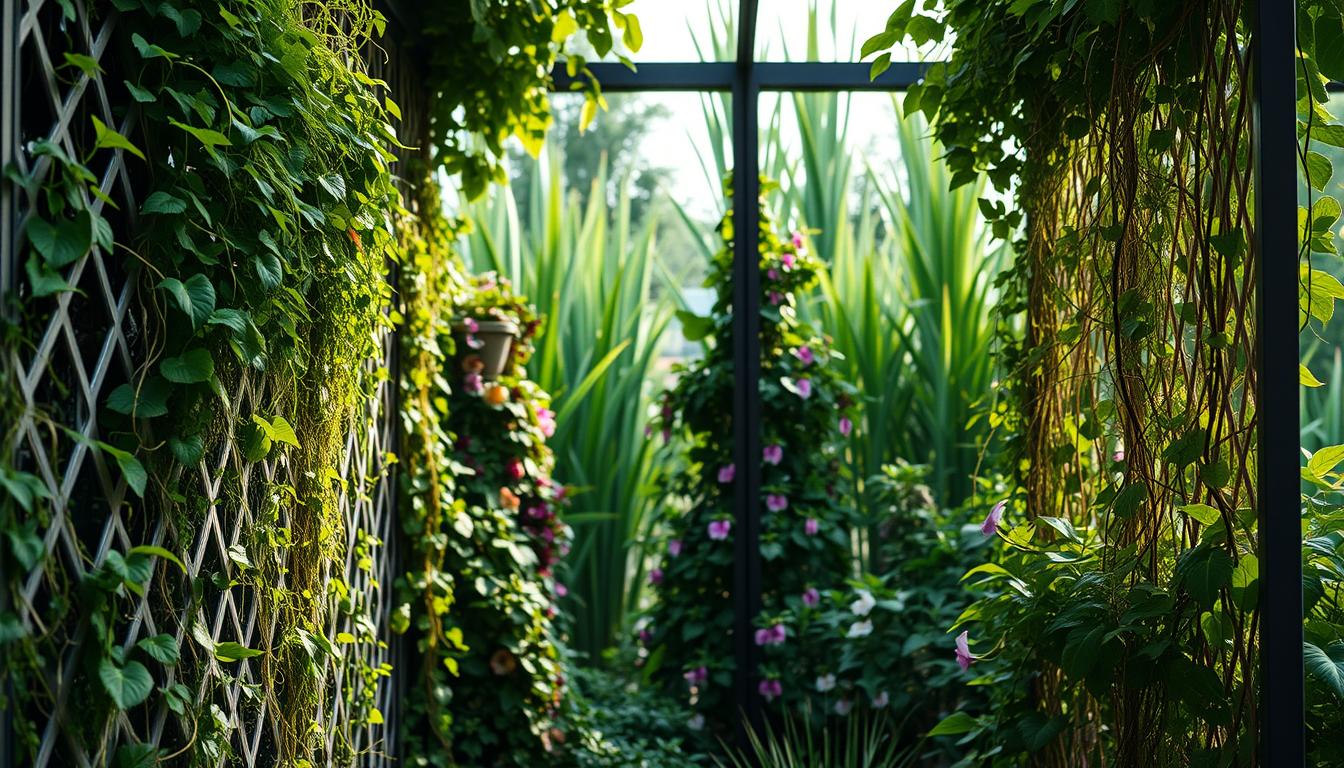Imagine turning your garden into a lush, three-dimensional paradise. By growing plants up instead of out, you can double your space. This method works for any size garden, from small balconies to big yards.
Garden supports do more than save space. They also create privacy, define areas, and show off plant beauty. The right support can turn a wall or fence into a colorful, textured living wall.
Whether you’re growing vines or edible climbers, the right support is key. Your choice of material and design affects plant health and garden look.
In this guide, we’ll look at classic wooden lattices to modern metal designs. We’ll also cover DIY options and special supports for certain plants. You’ll learn how to pick the best structure for your garden, budget, and needs.
The Vertical Revolution in Garden Design
Exploring the vertical side of gardening opens up new possibilities. Traditional gardening can’t match the creativity of vertical gardening. It turns simple gardens into layered ecosystems that catch the eye and grow more.
Vertical gardening is more than hanging pots. It’s a way to rethink space. With the right trellis systems, gardens can change with the seasons.
Why Vertical Gardening Transforms Spaces
Vertical gardening can change any space. A blank fence turns into a colorful wall. A small balcony can grow veggies.
Vertical elements add structure and interest. They create natural dividers and focal points. For small gardens, growing up makes them seem bigger.
Trellises are key in vertical gardening. They support plants and add beauty. They:
- Define spaces for climbing plants
- Add interest in winter
- Show off seasonal flowers
- Solve space issues
The Environmental Benefits of Growing Upward
Vertical gardening is good for the planet too. Plants get better air, which means fewer diseases and pests. This means less chemicals and healthier plants.
Vertical gardens create their own climates. Trellises shade some plants and let others get sun. This helps plants grow better.
Upward growth saves water. Plants don’t lose as much water when they climb. The structure also shades the soil, keeping it moist.
Vertical gardens also attract wildlife. Climbing plants offer homes for birds. Flowering vines feed pollinators. This makes gardens stronger and more diverse.
Understanding Trellis for Climbing Plants
Every thriving vertical garden has a special trellis system. This system helps climbing plants grow well. It affects how strong the stems are and how many flowers they produce.
Trellises turn gardens into three-dimensional spaces. Plants grow up them, creating green walls that change with the seasons. This makes the garden look amazing.
How Trellises Support Plant Growth Cycles
Trellises are key for climbing plants at every stage. They help young stems grow towards sunlight. This makes the stems stronger and the leaves more efficient.
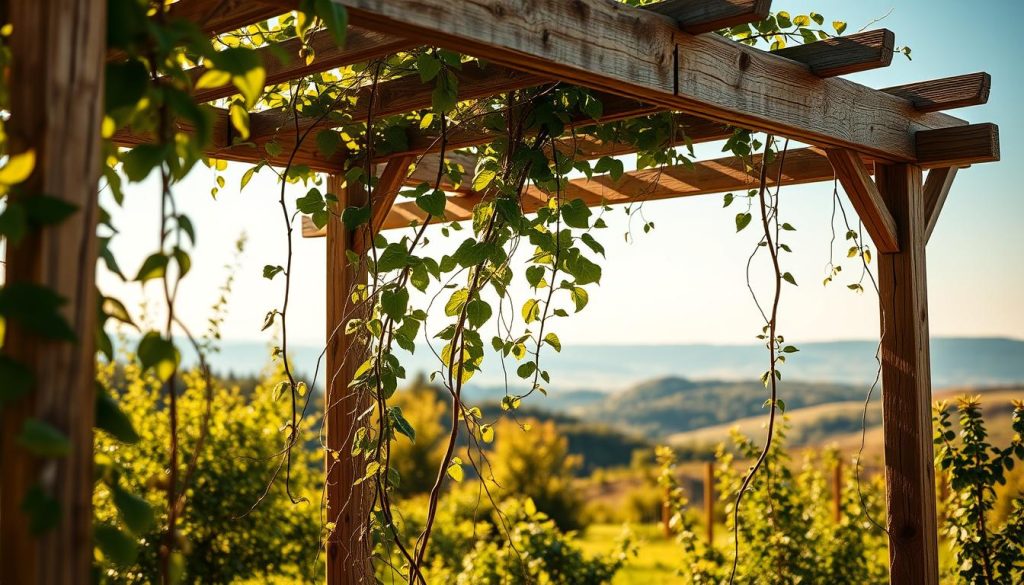
As plants get older, trellises keep stems from breaking. This lets plants focus on growing more flowers and fruits. They produce more than plants without supports.
Good supports also help plants breathe better. This reduces diseases caused by too much moisture. Plants on trellises often have fewer pests and diseases.
Matching Trellis Styles to Plant Climbing Mechanisms
Not all plants climb the same way. That’s why there are different trellis designs. Knowing how a plant climbs helps pick the right trellis.
Plants have evolved many ways to climb. Some wrap around thin supports, while others cling to flat surfaces. The right trellis lets plants climb easily.
Twining Plants vs. Clinging Plants
Twining plants, like morning glories, wrap around supports. They do well on thin supports like string trellises. This lets them grow freely.
Clinging plants, like ivy, stick to surfaces. They prefer flat, textured supports like wooden panels. This helps them spread out.
Scrambling Plants vs. Plants with Tendrils
Scrambling plants, like climbing roses, grow long stems. They need sturdy trellises to train them. Regular care keeps them growing well.
Plants with tendrils, like peas, reach out with special parts. They do well on supports with lots of thin elements. This lets them attach easily as they grow.
Classic Wooden Trellis Designs
Classic wooden trellis designs are loved for their beauty and function. They have been in gardens for centuries, changing from simple supports to beautiful garden features. Wood adds warmth to gardens and is perfect for climbing plants to show off.
Lattice Panels: Timeless Garden Staples
Lattice panels are a top pick for adding tradition to gardens. They have wooden slats that make diamond or square patterns. These patterns are great for climbing plants like roses and jasmine.
Lattice panels come in different sizes to fit various plants and garden styles. Smaller ones are better for delicate plants, while bigger ones let in more air. They work well in many garden types, from cottage to modern.
Cedar and Redwood Options for Longevity
Cedar and redwood are top choices for durable garden decor. They resist rot and insects naturally. A cedar trellis can last 15-20 years with little care.
Cedar turns silver-gray with age, adding charm to gardens. Redwood is reddish-brown and just as durable. Both can be left to weather or sealed to keep their color. Regular checks and cleaning help them last longer.
Obelisks and Arbors as Statement Pieces
Wooden obelisks and arbors make great focal points in gardens. They add vertical interest and beauty. An obelisk in a border can turn into a tower of flowers with climbing plants.
Arbors are amazing as garden gateways, marking different areas of the garden. Covered in vines, they create enchanting paths. These structures need proper support and occasional upkeep to stay strong and beautiful.
Metal Trellis Options for Durability and Style
Metal trellises are perfect for gardeners who want strong and stylish support. They last longer than wood and handle bad weather well. These structures are not just for plants; they also add beauty to your garden all year.
There are many metal trellis types, each fitting different garden styles. Whether you like classic or modern, you’ll find a metal trellis that matches your garden. They also last for decades, making them a great choice.
- Exceptional durability against weather elements
- Minimal maintenance requirements
- Ability to support heavier climbing plants
- Year-round visual interest, even when plants are dormant
- Wide range of design possibilities
Wrought Iron Elegance in Traditional Gardens
Wrought iron trellises add elegance to traditional gardens. They have beautiful details that remind you of old times. These structures support strong plants like roses and wisteria.
Wrought iron is strong, making it perfect for detailed designs. It looks delicate but is very durable. Many become family treasures, lasting for generations.
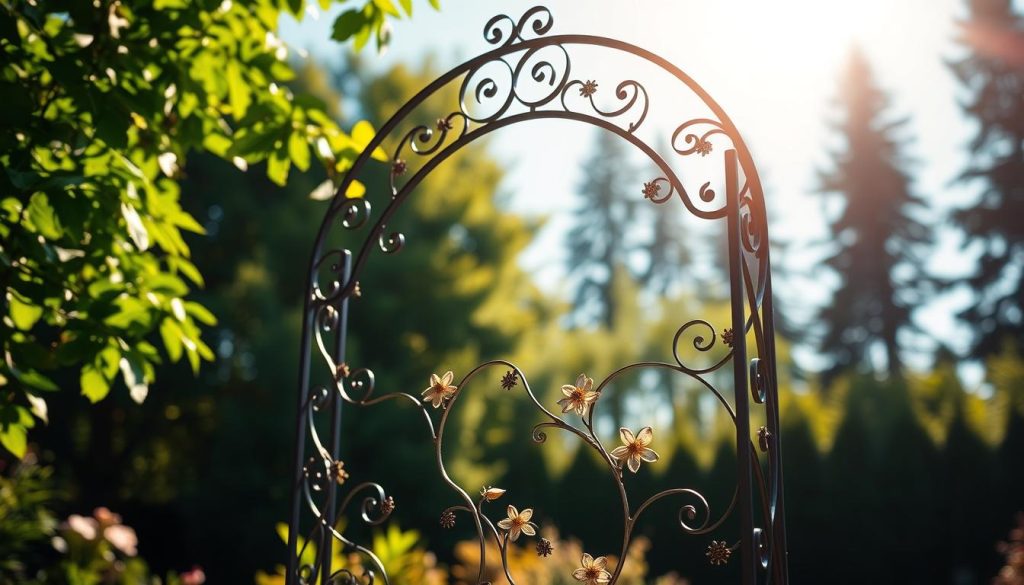
Powder-Coated Steel for Modern Aesthetics
Modern gardens look great with powder-coated steel trellises. They come in many colors and can be bold or blend in. The powder coating protects them from damage.
Steel trellises are strong but lighter than iron. They fit well in simple gardens and support climbing plants. You can also customize them to fit your garden.
Copper and Bronze Trellises That Age Beautifully
Copper and bronze trellises are special because they change color over time. They start bright and turn into beautiful greens, blues, and browns. Each one becomes unique, showing how it’s aged.
These metals are also good for plants because they fight off bacteria. They are heavy but not as much as iron. Their warm colors make gardens feel welcoming, even in the morning or evening.
When picking a metal trellis, think about its weight. It’s important for setting it up right. Even though they need little care, check them now and then to keep them safe and strong for your plants.
Natural and Sustainable Trellis Materials
Looking for eco-friendly options for your climbing plants? Natural and sustainable trellis materials are both beautiful and good for the planet. They help your garden grow while being kind to the earth. More gardeners are choosing these natural materials over plastic and metal.
Bamboo Structures: Lightweight and Eco-Friendly
Bamboo is a top choice for garden structures. It grows fast, reaching harvest in 3-5 years. This is much quicker than hardwoods, which take decades.
Bamboo is strong yet light, making it great for plant supports. You can move it around easily as your garden changes. It’s easy to create beautiful shapes with bamboo and natural twine.
Bamboo is perfect for climbing veggies like beans and peas. It adds a touch of Asian beauty to your garden. Treated bamboo can last 5-7 years, making it a smart choice for eco-friendly gardeners.
Willow and Hazel Woven Supports
Willow and hazel branches add charm and beauty to gardens. They can be cut from trees every year, making them sustainable. This cycle of growth and use is great for the environment.
These branches are flexible and perfect for weaving into supports. You can make panels, hoops, and even living willow structures. These grow and root in moist soil.
Willow and hazel fit well in natural gardens. They support plants without taking over. Their warm colors complement vines like clematis and morning glories beautifully.
Biodegradable Options for Seasonal Gardens
For gardens that change with the seasons, biodegradable supports are ideal. Materials like jute twine and sisal rope support plants for a season before breaking down. This is great for zero-waste gardening.
These supports work well for annual vines and veggies. At the end of the season, cut them down and compost them. This way, you won’t leave any waste behind.
For container gardens, use untreated wood stakes and twine. Even dried sunflower stalks can be used as supports for young plants. This approach is waste-free and eco-friendly.
| Natural Material | Durability | Best Uses | Maintenance | Cost Range |
|---|---|---|---|---|
| Bamboo | 5-7 years | Arches, grids, tepees | Low; occasional sealing | $10-$30 |
| Willow | 2-3 years | Woven panels, hoops | Medium; annual inspection | $15-$40 |
| Hazel | 3-4 years | Rustic frames, obelisks | Low; minimal treatment | $20-$45 |
| Jute/Sisal | 1 season | Annual climbers, peas | None; compostable | $5-$15 |
| Cotton Netting | 1-2 seasons | Cucumbers, melons | None; biodegradable | $8-$20 |
DIY Trellis Projects for Unique Garden Spaces
Handcrafted trellises from upcycled materials add character and sustainability to gardens. They save money and let you tailor supports to your plants and garden’s look. With basic tools and imagination, you can turn ordinary objects into amazing garden features that tell your story.
Upcycled Materials That Make Stunning Supports
DIY trellis projects turn trash into treasure. Upcycling gives new life to old items, making them functional and full of history. These structures often develop beautiful patinas and textures that enhance your garden’s story.
Successful upcycled trellises need sturdy construction and proper plant support. Choose materials that can handle the weather and meet your plants’ needs. Different plants require different supports, from delicate to substantial.
Repurposed Ladders and Furniture
Wooden ladders become instant vertical gardens when leaned against walls or fences. Their rungs support climbing roses or jasmine. Secure the ladder and angle it for best plant growth.
Old wooden headboards, chair backs, and even baby cribs make charming trellises. Remove unsafe elements, treat the wood, and position them as garden focal points.
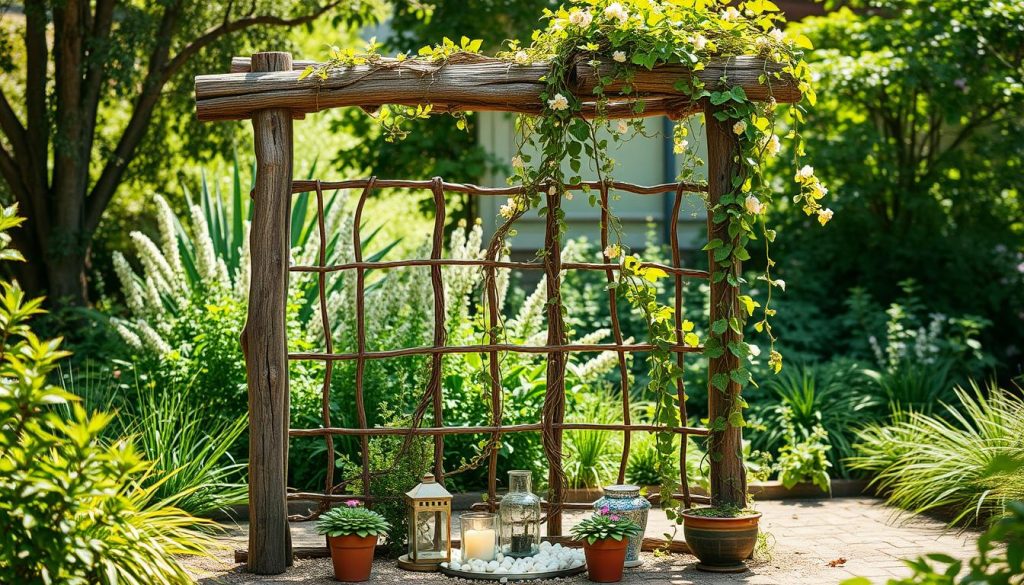
Bicycle wheels create stunning circular supports for climbing plants. Mount a wheel horizontally for a wagon-wheel effect or vertically for a living wall. The spokes guide delicate climbers like clematis or morning glories.
Industrial salvage items add an edgy contrast to your garden. Metal grates, old fencing panels, and architectural remnants support vigorous climbers. They add industrial chic to your garden design.
Weekend Projects That Transform Gardens
You don’t need advanced carpentry skills for impressive garden structures. Many DIY trellis projects need just a few hours and basic tools. Seeing plants climb structures you made adds joy to gardening.
Branch trellises are a simple weekend project. Gather fallen branches, arrange them in a grid or fan pattern, and secure with twine or wire. The natural look blends with plantings while providing support.
Creating cattle panel arches is a more substantial project. These panels, available at agricultural stores, can be bent into arches and secured with stakes. Plant climbers on both sides for a stunning walkway tunnel effect.
String grid systems work well for annual climbers like morning glories. Install sturdy posts and create patterns with twine or fishing line. These supports let plants be the stars while providing structure.
Specialized Trellises for Vegetable Gardens
Maximize your harvest while saving space with specialized trellises for vegetables. Vertical gardening boosts yields and improves air circulation. It also makes harvesting easier. The right support system can transform your garden into a productive and organized space.
Different vegetables have unique climbing habits and weight needs. This makes specialized trellis designs key for vertical gardening. Let’s look at the best support systems for climbing vegetables to grow more food in less space.
Tomato and Cucumber Support Systems
Tomatoes and cucumbers are top choices for vertical growing. They need sturdy but different support systems. Tomatoes do well with cages for determinate varieties, but indeterminate types need string trellises or A-frames.
Cucumber vines prefer mesh panels or string grids for their delicate tendrils. These climbers can easily climb netting systems or frames. Proper support prevents disease by improving air circulation.
The Florida weave system is a budget-friendly option for supporting tomatoes. It uses stakes and twine for horizontal supports. This method is great for gardeners who need to support many plants.
| Support Type | Best For | Pros | Cons | Cost Range |
|---|---|---|---|---|
| Tomato Cage | Determinate tomatoes | Easy setup, reusable | Too small for indeterminate varieties | $5-15 each |
| String Trellis | Indeterminate tomatoes, cucumbers | Adjustable height, inexpensive | Requires regular maintenance | $10-30 total |
| A-Frame Support | Multiple vegetable types | Sturdy, maximizes space | More complex to build | $25-75 |
| Netting System | Cucumbers, peas | Multiple attachment points | Less durable than metal options | $15-40 |
Bean Towers and Pea Tunnels
Legumes like beans and peas are natural climbers. They turn vertical supports into lush, productive towers. Pole beans can grow up to 10-12 feet tall, making tepee structures or tall towers ideal.
Pea tunnels and arches are great for growing peas and as charming garden pathways. A simple arch made from cattle panels or PVC pipe covered with netting creates a walkway that produces peas at eye level. For smaller spaces, flat panel trellises work well for both peas and beans.
Peas use tendrils to grip supports, while beans twine their stems around structures. This means peas need mesh or string with small openings, while beans can climb larger supports like poles or thick twine.
Squash and Melon Vertical Growing Solutions
Growing heavy fruits like squash, melons, and pumpkins vertically presents challenges but saves space. The key is strong structural support for vines and additional support for developing fruits. Reinforced A-frames or wall-mounted heavy-duty trellises work well for the vines themselves.
For supporting the weight of developing fruits, fabric slings or hammock systems prevent fruits from detaching prematurely. These can be made from stretchy materials like old t-shirts, pantyhose, or specialized plant slings. Simply tie the fabric beneath forming fruits and secure it to the trellis structure above.
Vertical growing reduces ground contact for these vegetables, minimizing pest issues and soil-borne diseases. It also improves air circulation, resulting in better-shaped fruits with more even coloration. For smaller varieties like summer squash and cucamelons, standard cucumber trellises often provide sufficient support without additional fruit slings.
Flower-Specific Trellis Designs
Choosing the right trellis design is key in flower gardening. Each flowering vine has its own growth habits and support needs. This knowledge helps gardeners create beautiful vertical displays while keeping plants healthy.
Different climbing aids serve specific purposes for various flowering plants. Some vines twine naturally, while others need attachment points. The weight, growth rate, and blooming patterns of each plant species dictate the best trellis design.
Rose Supports and Clematis Frames
Climbing roses and clematis are the royalty of vertical flower gardening. Roses need sturdy, fan-shaped trellises or obelisks to support their weight. Look for structures with wide openings for easy training and pruning.
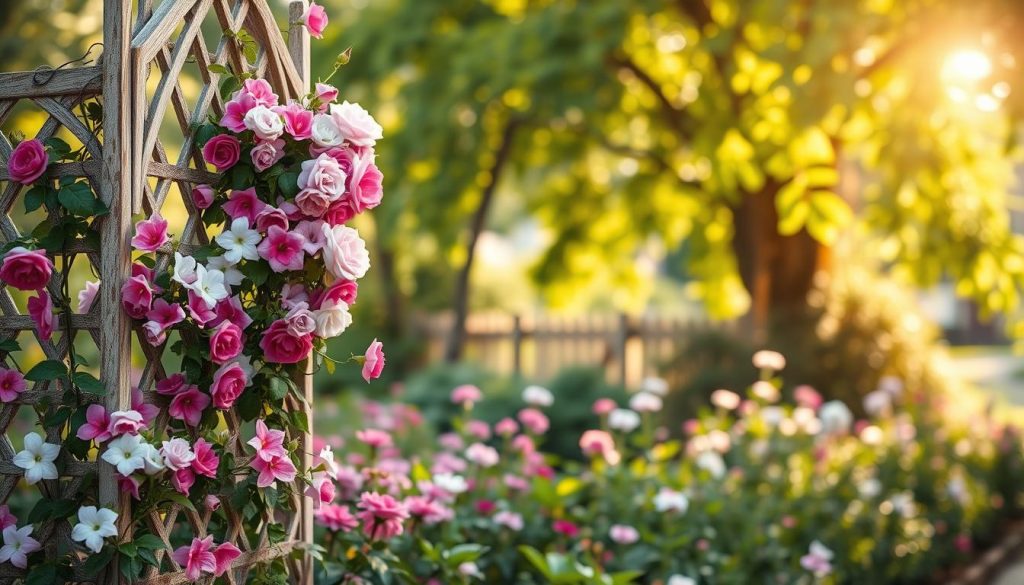
Clematis thrive with horizontal supports that showcase their blooms. Their slender stems wrap around thin supports, making wire grids and string systems ideal. Many gardeners pair roses and clematis on the same trellis, creating a stunning display.
For this classic pairing, choose a trellis at least 6-8 feet tall with both vertical and horizontal elements. Ensure the structure is anchored securely, as mature plants can become surprisingly heavy, even when wet.
Morning Glory and Moonflower Climbing Structures
Annual vines like morning glories and moonflowers grow rapidly. They require different climbing aids than their perennial counterparts. These fast-growing beauties perform wonderfully on lightweight, expandable trellises, string systems, or netting that can be easily deployed each season.
Morning glories climb by twining their entire stems around supports, preferring structures with thin elements spaced 2-4 inches apart. Their cousins, moonflowers, share similar growing habits but benefit from strategic placement where evening blooms can be appreciated.
Consider installing string trellises with multiple vertical lines for these vigorous climbers. A simple frame with twine or fishing line strung vertically creates the perfect climbing structure. For dramatic effect, create tepee shapes or archways that showcase the abundant blooms of these annual climbers.
Wisteria and Honeysuckle Management Systems
Vigorous woody vines like wisteria and honeysuckle demand exceptionally sturdy support systems. These powerful climbers can eventually reach weights that collapse inadequate structures. For wisteria, consider pergolas, arbors, or heavy-duty wall-mounted systems constructed from metal or thick wooden beams.
Honeysuckle, while slightly less aggressive than wisteria, still requires substantial support. Its twining habit works well on lattice panels, sturdy wire systems, or wooden structures with adequate attachment points. Both plants benefit from regular pruning to prevent them from overwhelming their supports.
When designing trellises for these robust climbers, plan for the future. Young plants may seem manageable, but mature specimens can exert hundreds of pounds of pressure on their supports. Install systems that are anchored into the ground or attached securely to buildings.
| Flowering Climber | Ideal Trellis Material | Support Structure | Maintenance Level | Special Considerations |
|---|---|---|---|---|
| Climbing Roses | Wood or Metal | Fan-shaped or Obelisk | High | Needs manual tying; requires sturdy anchoring |
| Clematis | Wire or Thin Metal | Grid with Horizontal Elements | Medium | Prefers cool roots; benefits from small diameter supports |
| Morning Glory | String or Netting | Vertical Lines or Tepee | Low | Annual; can self-seed aggressively |
| Wisteria | Heavy Metal or Timber | Pergola or Arbor | Very High | Extremely powerful; can damage structures if not managed |
| Honeysuckle | Metal or Wood Lattice | Grid or Panel | Medium-High | Vigorous growth; some varieties can become invasive |
Wall-Mounted and Space-Saving Trellis Systems
Wall-mounted trellis systems are great for gardeners with little space in cities. They turn blank walls, fences, and railings into garden spots. Even small balconies or patios can become lush gardens with climbing plants and vines.
There are many designs and materials for trellises to fit different tastes and needs. You can find wire systems that blend into the plants or decorative panels that stand out. There’s a perfect wall-mounted solution for every space problem.
Wall-mounted systems are great because they save floor space. They’re perfect for city dwellers, apartment gardeners, and anyone with limited space.
Balcony and Patio Solutions
Balconies and patios are great for vertical gardening with special trellis solutions. Railing planters with built-in trellises are all-in-one systems that fit balcony railings without harming them. They create instant vertical gardens.
Freestanding container trellises are also good for balconies and patios. They have a strong base that holds the plant and trellis. This makes them easy to move around.
Tension wire systems are great for renters. They use cables that can be set up without damaging walls. This makes vines look like they’re floating, adding magic to city views.
Fence-Mounted Options for Boundary Enhancement
Fences can be turned into vertical gardens with the right trellis attachments. Adding lattice toppers to wooden fences increases growing space and adds beauty. This doubles your garden area while softening fence lines.
Chain-link fences can become living walls with vine guides. Systems like weaving, clip-on panels, and brackets make it easy to cover the fence with plants.
Privacy screens are possible with dense climbers and trellis systems along property lines. This creates natural boundaries that help wildlife and define garden areas.
Installation Techniques for Various Surfaces
Proper installation is key for a trellis to support plants well. Different surfaces need specific hardware and methods for secure mounting without damage.
For masonry walls, use masonry anchors or concrete screws. Make sure to leave a small gap for airflow and to prevent moisture damage.
Mounting to wood siding or fence posts requires stainless steel screws for weather resistance. Always aim for structural supports for maximum strength.
| Surface Type | Recommended Hardware | Special Considerations | Weight Capacity |
|---|---|---|---|
| Brick/Concrete | Masonry anchors, concrete screws | Pre-drill holes, use wall plugs | High (50+ lbs) |
| Wood Siding | Stainless steel screws | Locate studs for mounting | Medium (30-40 lbs) |
| Vinyl Siding | Siding hooks, special brackets | Avoid puncturing vapor barrier | Low (15-25 lbs) |
| Metal Railings | U-bolts, clamp systems | No drilling required | Medium (20-35 lbs) |
Weather-Resistant Trellis Selection for Year-Round Gardens
Keeping climbing gardens beautiful all year is a big challenge. You need trellises that can handle cold, heat, and everything in between. The right materials and designs for your area can make your trellis last for decades.
Winter-Hardy Materials and Designs
Choosing the right trellis for cold winters is key. Powder-coated steel and aluminum are great because they don’t rust. Cedar and redwood are also good because they resist rot and bugs.
Designs matter too. Look for trellises with strong joints and good anchoring. Angled tops help snow slide off, preventing damage.
In very cold areas, composite materials are a good choice. They mix wood’s look with plastic’s strength. They cost more upfront but last a long time.
Seasonal Adaptations and Protective Measures
Adaptable trellises are smart for changing seasons. Modular designs let you adjust as plants grow or change. Collapsible options make maintenance easier during bad weather.
Protecting your trellis helps it last longer. Use UV-resistant sealants on wood in summer. Check metal trellises for rust and paint them as needed.
Every area has its own challenges. Coastal areas need marine-grade steel or treated wood. High-wind spots need low-profile designs with extra anchors. Hot areas should use light-colored materials to prevent damage. With the right care, your trellis will support plants for years.
Budget-Friendly to Luxury Trellis Options
Whether you’re gardening on a tight budget or want to splurge on a stunning focal point, there’s a trellis for you. Vertical gardening is accessible and affordable. You can create beautiful displays without breaking the bank. Or, if you’re willing to spend more, you can find trellises that are both beautiful and functional.
Affordable Solutions Under $50
If you’re watching your budget, don’t worry. There are many affordable trellis options. Big-box stores and garden centers have vinyl lattice frames and metal grids. These are great for climbing plants and look clean and simple.
Expandable willow trellises are charming and affordable, often under $30. They’re perfect for annual vines like morning glories. For the very budget-conscious, making your own trellis from repurposed materials can be free or very cheap.
- Plastic-coated wire panels ($15-25)
- Expandable wooden lattice frames ($25-40)
- Simple bamboo stake tepees ($10-20)
- Repurposed items like old ladders or bed frames (free to $15)
Mid-Range Investment Pieces $50-$200
In the mid-range, you get better durability and design. Cedar and redwood trellises last 10+ years with care. They develop a beautiful patina over time, adding character to your garden.
Powder-coated steel options are strong and stylish. Look for architectural arches and obelisks for dramatic vertical interest. Many mid-range pieces have decorative finials and patterns that make them stand out.
These pieces are a good investment because they last longer. They don’t need to be replaced as often as cheaper options.
Designer and Custom Trellises for Distinctive Gardens
For gardens that demand the extraordinary, designer and custom trellises are the way to go. Hand-forged metal work by artisan blacksmiths creates unique pieces. Prices start around $300 and can go up to thousands.
Commissioned wooden structures can match your home’s architecture. They use unique joinery and premium hardwoods. These pieces are a big investment but make your garden truly special.
Working with landscape designers can create trellis systems that fit your garden perfectly. These statement pieces elevate your garden decor. They create memorable moments that delight visitors and bring joy for years.
Creating Your Vertical Paradise: Transforming Gardens with the Right Trellis
Ready to elevate your garden? The right trellis can transform any space into a stunning vertical paradise. First, think about what you need – your climate, space, and favorite plants.
Choosing the right trellis involves three things: your plants’ climbing style, your garden’s look, and your budget. Clematis loves thin wire, while big vines need strong wooden trellises. Pick the best support for your plants.
Put your trellis in a sunny spot for your plants. Make sure it’s stable before planting to avoid damage. Use soft ties to guide young plants to their supports without harming them.
One trellis can change your garden a lot. A blank wall becomes a flower show. A simple patio turns into a lush oasis. Small areas get bigger with vertical gardening.
Start with one trellis and learn as you go. Vertical gardening brings joy every season as plants grow. Your garden will grow taller, deeper, and more beautiful over time.
Start your vertical gardening adventure today. Your dream garden is just a trellis away.

